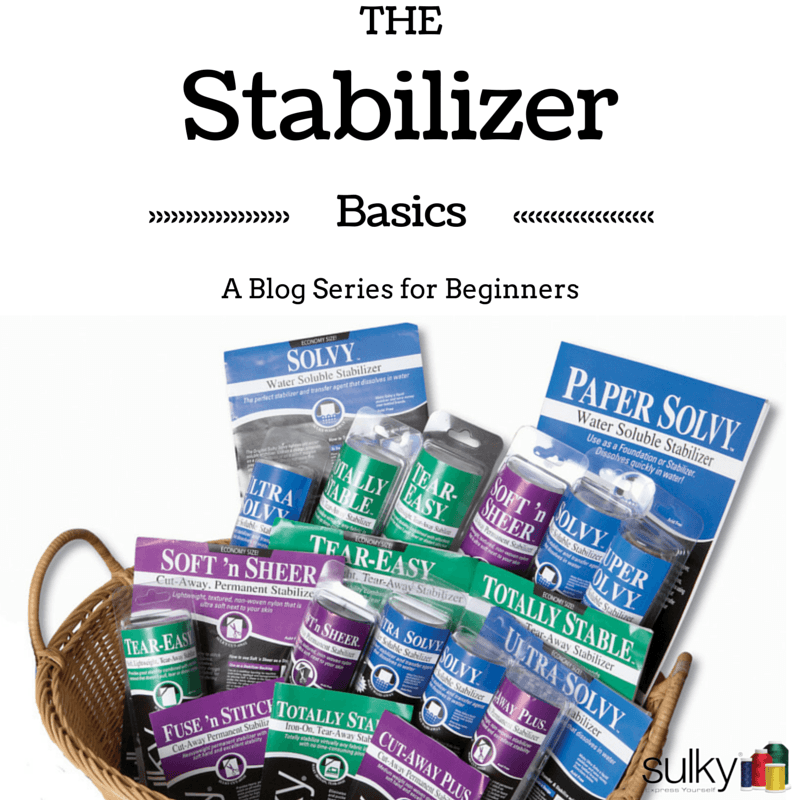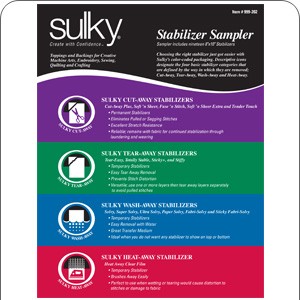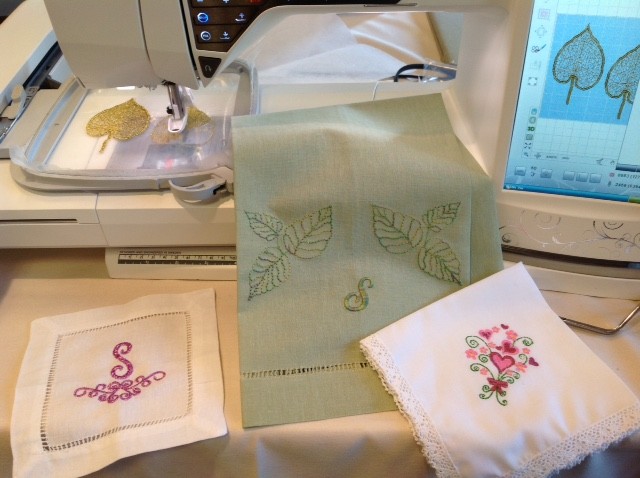
I have a confession to make. Although I have been sewing since I was a child, I am very very new to machine embroidery. The truth is, when I started this job with Sulky the most complex thing I could do on an embroidery machine is use the alphabet that is built in the machine in order to put a name or letter onto a towel. Don’t get me wrong, I owned all the right stuff. I had all the stabilizers, I had books, I even had friends who knew what they were doing and they were willing to answer any question that I had. The problem is, I had no idea what questions to ask! Since starting this job, I have learned a little bit more about machine embroidery and a whole lot more about stabilizers. They really can be the difference between something looking okay and something turning out amazing. But if you use the wrong stabilizer, they can make your project look awful too.
For the next several weeks, I will be doing a series about stabilizers. I will answer all the questions you either didn’t know to ask or were too afraid to ask. This series is for beginners and I am hoping that all my really experienced embroiderers will chime in with helpful hints and advice in the comments.
Today I want to start by answering a few basic questions that I was too afraid to ask in the beginning:
Why the heck do you need a stabilizer in the first place? The answer to that, strangely enough, is right there in the word stabilizer, it is for stability! When a needle is going through fabric thousands of times and layering up a bunch of thread, the fabric itself can pucker, tunnel or distort. Stabilizers relieve the stress placed on the fabric and eliminate these unwanted reactions.
Where do you use stabilizer? Stabilizer is most often used as a backing to support machine embroidery stitching on fabric. It is also used as a topper on top of fabric to help hold down the nap of the fabric, to keep stitches from sinking into some fabrics, and/or to enhance the clarity of fine lettering and detail stitching. Toppers are also used as a pattern, stencil or template to follow when stitching or thread sketching. Increasingly, sewist and fiber artists are using stabilizers beyond machine embroidery too! I will show you some of the cool new ways people are using Sulky Stabilizers in this series as well.
Why should you use Sulky Stabilizers? Sulky Stabilizers are carefully and thoughtfully engineered to enhance every creative project and solve even the most difficult problems. They are made of the highest quality materials, and quality is extremely important since inexpensive, poor quality stabilizers can cause poor registration of embroidery and premature tearing, among other problems. Think about it. You spent a ton of money on your embroidery machine, a small fortune on fabric and have spent more than the cost of a good cup of coffee on thread. When a good quality stabilizer can be the difference between a great project and one that you wouldn’t even show your closest friends, why wouldn’t you use the best?  Most of the Sulky Stabilizers available to you have actually come from the industrial side of the business through our manufacturing partner, Gunold.  So they have been thoroughly tested on the professional side of embroidery, too.

So as this series goes on, I hope we will all learn some great things about stabilizers. Do you have questions that you want to be sure that I answer? Put them in the comments and I will be sure that they all get addressed. Until next week, Happy Sewing!



I have a medium weight polyester knit, and I want to applique shapes that are cut out of Ultra Suede all over the fronts and back. The knit is very stretchy, I need to use my walking foot, and will be turning the fabric quite a bit and I need to temporarily stabilize to eliminate the stretch. The key word is temporary in terms of the stabilization. The only stabilizer I can think of is the sticky wash away? Your suggestions please.
Good idea. This will be a good series. Thanks
My favorite things to embroider are T-shirts and sweatshirts. I have used Totally Stable for years with good results, sometimes using 2 layers. I’ve read instructions lately for using cut-away for sweatshirts. What do you do for the stiffness leftover, especially for babies and children?
I. also use stabilizer to do machine applique and under decorative stitches. Everything lies much flatter and puckering is eliminated.
What stabilizer to use if the project will touch skin and you want it to be soft? When should one use 2 sheets of stabilizer instead of just one for best results?
How many stitches in an embroidery design would dictate more than one layer of stabilizer?
So, this is looking like a very helpful, educational blog – stabilizers!! Can you tell me, what stabilizer do I use to fuse wool to wool, wool to flannel so that I can hand or machine stitch with appliqué stitches?
Thanks for the help. And, HAPPY NEW YEAR!!!!
I found this very informative even though I have been embroidering for a while. Looking forward to the next blog.
Why is it that some tear-away stabilizers (including Sulky) don’t tear away cleanly? Or destroy stitching when removing them? Do you have any suggestions on how to avoid them?
I just received this e-mail about the Stabilizer Basics, Jan 15 2015.. I need to know if there is a soft hand stabilizer that is adhesive on both sides.
Thank you,
C. Jackson
I only use the Sulky sticky back for my fur fabric embroidery. Thank you for a great product.
Could you recommend a stabilizer to use when embroidering relatively thin cotton cotton fabric to to embroider small (half inch max) text on labels for quilts.
Thanks for this series. Am very much looking forward to learning. However, I am finding the words difficult to read that are under the photos because the font, although large is in a very light colour. Not sure if this is bothering anyone else or if there is something I can do at my end. I don’t usually have this problem.. Thanks.
I agree… the words are TOO LIGHT.I hope someone takes note and corrects this….
The words do appear lighter on some computers than on others. I have noticed it myself. I will see if I can “darken them up”
I just had an embroidery machine given to me and I’d love to know more about the whole thing! What should I get to start with on the machine? Do I start with a certain fabric, stabilizer and threads? or what???????Help!
Thank you for all the great questions! Instead of answering each question in the comments, I am collecting all of these and doing a new post “Answering Your Questions on Stabilizers.” Expect the post next week!